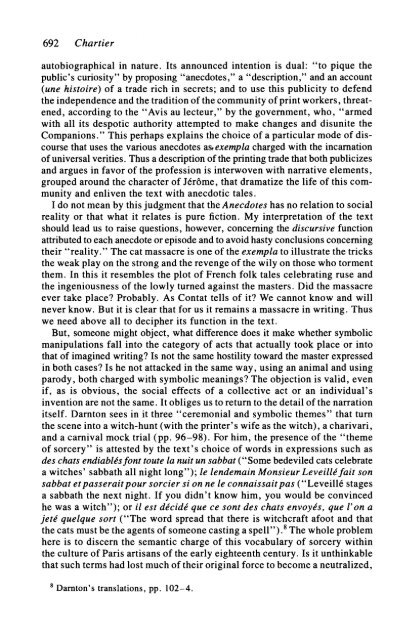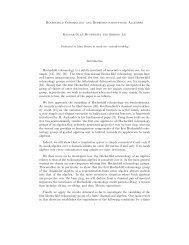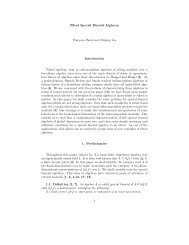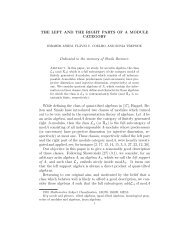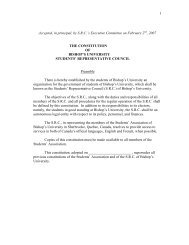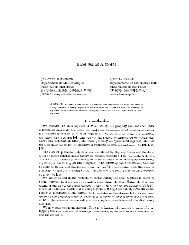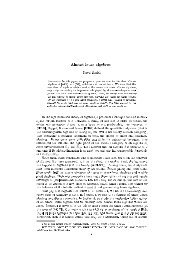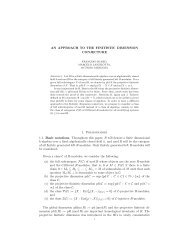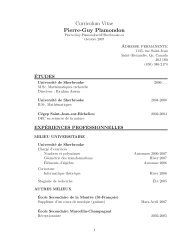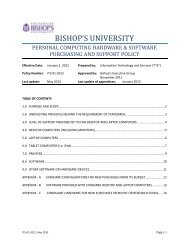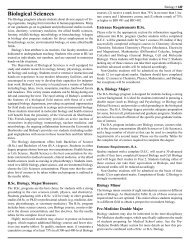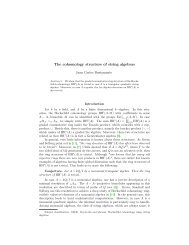Review: Text, Symbols, and Frenchness Roger Chartier The Journal ...
Review: Text, Symbols, and Frenchness Roger Chartier The Journal ...
Review: Text, Symbols, and Frenchness Roger Chartier The Journal ...
You also want an ePaper? Increase the reach of your titles
YUMPU automatically turns print PDFs into web optimized ePapers that Google loves.
692 <strong>Chartier</strong><br />
autobiographical in nature. Its announced intention is dual: "to pique the<br />
public's curiosity" by proposing "anecdotes," a "description," <strong>and</strong> an account<br />
(une histoire) of a trade rich in secrets; <strong>and</strong> to use this publicity to defend<br />
the independence <strong>and</strong> the tradition of the community of print workers, threatened,<br />
according to the "Avis au lecteur," by the government, who, "armed<br />
with all its despotic authority attempted to make changes <strong>and</strong> disunite the<br />
Companions." This perhaps explains the choice of a particular mode of discourse<br />
that uses the various anecdotes as exempla charged with the incarnation<br />
of universal verities. Thus a description of the printing trade that both publicizes<br />
<strong>and</strong> argues in favor of the profession is interwoven with narrative elements,<br />
grouped around the character of JCrBme, that dramatize the life of this community<br />
<strong>and</strong> enliven the text with anecdotic tales.<br />
I do not mean by this judgment that the Anecdotes has no relation to social<br />
reality or that what it relates is pure fiction. My interpretation of the text<br />
should lead us to raise questions, however, concerning the discursive function<br />
attributed to each anecdote or episode <strong>and</strong> to avoid hasty conclusions concerning<br />
their "reality." <strong>The</strong> cat massacre is one of the exempla to illustrate the tricks<br />
the weak play on the strong <strong>and</strong> the revenge of the wily on those who torment<br />
them. In this it resembles the plot of French folk tales celebrating ruse <strong>and</strong><br />
the ingeniousness of the lowly turned against the masters. Did the massacre<br />
ever take place? Probably. As Contat tells of it? We cannot know <strong>and</strong> will<br />
never know. But it is clear that for us it remains a massacre in writing. Thus<br />
we need above all to decipher its function in the text.<br />
But, someone might object, what difference does it make whether symbolic<br />
manipulations fall into the category of acts that actually took place or into<br />
that of imagined writing? Is not the same hostility toward the master expressed<br />
in both cases? Is he not attacked in the same way, using an animal <strong>and</strong> using<br />
parody, both charged with symbolic meanings? <strong>The</strong> objection is valid, even<br />
if, as is obvious, the social effects of a collective act or an individual's<br />
invention are not the same. It obliges us to return to the detail of the narration<br />
itself. Darnton sees in it three "ceremonial <strong>and</strong> symbolic themes" that turn<br />
the scene into a witch-hunt (with the printer's wife as the witch), a charivari,<br />
<strong>and</strong> a carnival mock trial (pp. 96-98). For him, the presence of the "theme<br />
of sorcery" is attested by the text's choice of words in expressions such as<br />
des chats endiable's font toute la nuit un sabbat ("Some bedeviled cats celebrate<br />
a witches' sabbath all night long"); le lendemain Monsieur Leveille' fait son<br />
sabbat etpasseraitpour sorcier si on ne le connaissaitpas ("LeveillC stages<br />
a sabbath the next night. If you didn't know him, you would be convinced<br />
he was a witch"); or il est de'cide' que ce sont des chats envoye's, que l'on a<br />
jete' quelque sort ("<strong>The</strong> word spread that there is witchcraft afoot <strong>and</strong> that<br />
the cats must be the agents of someone casting a spell").8 <strong>The</strong> whole problem<br />
here is to discern the semantic charge of this vocabulary of sorcery within<br />
the culture of Paris artisans of the early eighteenth century. Is it unthinkable<br />
that such terms had lost much of their original force to become a neutralized,<br />
' Darnton's translations, pp. 102-4.


